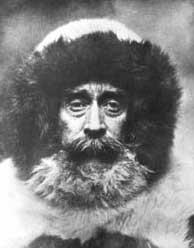Peary, Robert (1856–1920)

Route followed by Robert Peary on his journey to the North Pole.
In September 1909 the Peary Arctic Club received a message with the word 'Sun.' It was the prearranged signal that the North Pole had been reached. The message had been sent by the American explorer Robert Peary, who had come to the end of his journey on 6 April 1909. It was the first time that man had reached this point on Earth's surface.
 |
Peary had been preparing for this journey for many years. He had made more than one attempt, but the intense cold and the tremendous difficulties of crossing the ice-fields had forced him to turn. But Peary never allowed himself to be discouraged and his determination overcame all the numerous obstacles.
The work of his expedition was made easier by the help he was given by the Eskimos. To win their sympathy he had learned to work as they did; he learned their methods of hunting and fishing; he lived in their igloos; and he ate and dressed as they did. When he had gained their confidence and friendship, Peary collected about seventy of them together (men, women, and children), and they all set off on the ship Roosevelt, taking with them 250 dogs, sledges, and the necessary provisions for a polar expedition. Peary set up his winter quarters at Cape Sheridan, and in January 1909 he pushed on with 23 companions to Cape Columbia, the northernmost point of Grant Land. On 22 February he started for the North Pole. The journey over ice-fields was carried out by a number of parties, one stage at a time. The first party stooped at latitude 85° 33'; the second at 86° 33', and the third at 87° 47'.
They were still 150 miles from their goal. At this point the last party, led by Peary himself, set off. It consisted of six men; Peary, his man-servant, and four Eskimos.
The journey was exhausting; the sledges moved forward day by day over the ice-fields in a cold so intense that it wore down the strength of both men and dogs. Every now and then the march had to be halted because the ice was interrupted by stretches of open sea. At the beginning of March the party stopped for six days until the water froze once more and they could continue their journey. They took the whole of March and the beginning of April to reach their goal. Finally, they reached the North Pole on 6 April 1909. Peary had achieved something that many explorers had already attempted without success.
Peary wrote in his diary: "The Pole at last! The prize of three centuries. My dream, my aim for twenty years. Mine at last." He planted the American flag in the ice and led his men in three rousing cheers.
The life of Robert Peary
Robert Peary was an officer in the American Navy. He was born in Pennsylvania in 1856, and was commissioned as a naval engineer in 1881. In 1886, at the age of thirty, he made his first expedition to Greenland, advancing with sledges about 100 miles into the interior of that enormous island. In 1891 the Academy of Sciences of Philadelphia appointed him leader of a new expedition to the extreme north of Greenland. During this expedition Peary reached latitude 82° with his sledges. Further expeditions to Greenland were organized by Peary in 1893 and 1895.
In 1899 the American explorer founded the Peary Arctic Club, whose purpose was to reach the Pole. Between 1898 and 1902 he set up bases in northern Greenland and in Grant Land from which he made expeditions northwards. During the first expedition in 1898 he suffered from frostbite in his feet and had to give up the journey. He made further attempts in 1900, 1902, and 1905. In the course of this last expedition he touched latitude 87° 6', thus beating all previous records. It was only in 1909, when he was 53 years old, that he achieved the goal to which he had dedicated the greater part of his life.
When he returned home, Robert Peary was loaded with honors and was promoted to the rank of admiral. The honors were all well deserved; they were the rewards for the faith of a man who had dedicated his whole being to a cause, and had endured setbacks, danger, and suffering with courage, so that one of the most remote parts of the world might become known.
